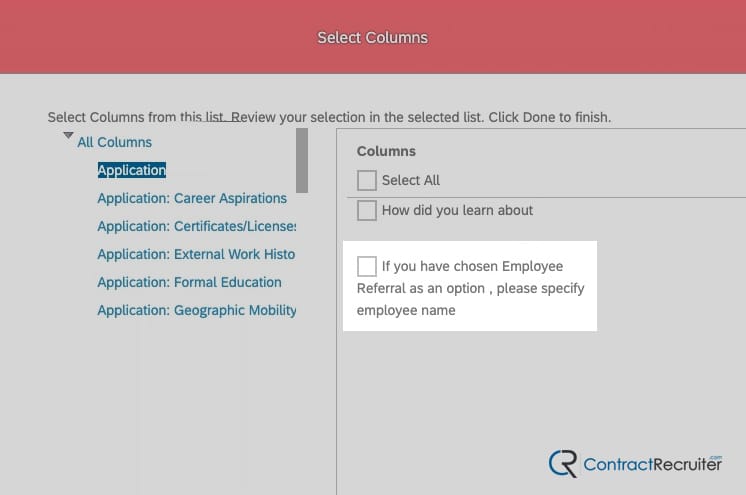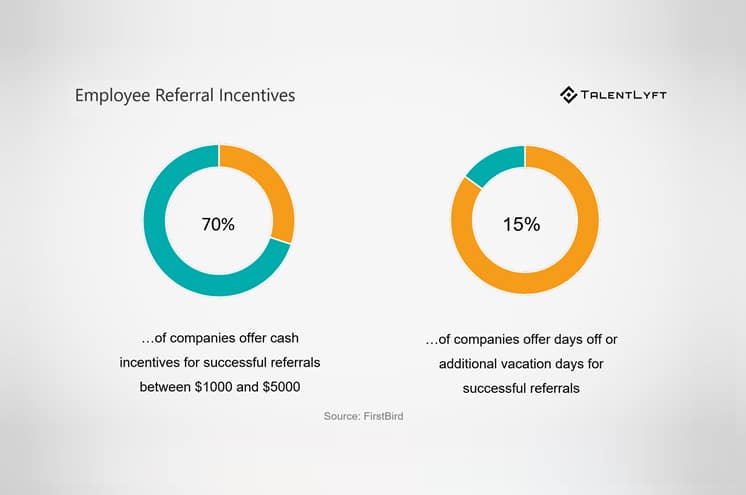No one in your entire company knows the ins and outs of a given role better than the people who currently hold it. It’s no surprise, then, that when it comes time to recruit someone to fill a gap, expand coverage, or grow the business, turning to the people currently working for you can be an excellent resource.
The most informal way to do this is to simply put out the word that you’re opening up a new position, and encourage your employees to share the job opening with people they know who might be interested in applying.
For a more formalized effort, though, you can go through the process of setting up an employee referral program.
What Does an Employee Referral Program Do?
At its core, an employee referral program does one thing: it encourages your current employees to recommend people for open roles. The idea is that this gets you a pool of qualified candidates with recommendations for their skills or how they would fit into the role with less effort than other forms of recruiting.
Employee referral programs can have varying levels of formality. One of the more informal examples is little more than a designated field in the application process to add in the employee’s name that referred them, if any.


More formal programs can pay bonuses for successful hires or offer other benefits to the referring employee.
There are a lot of different benefits and drawbacks to running an employee referral program, so let’s discuss them so that you can make an informed decision.
The Pros of an Employee Referral Program
First, let’s start with the benefits of an employee referral program. There are quite a few, and they’re quite powerful, which is why some businesses make use of such programs to gather candidates and hire new employees.


Your employees have a deep insight into the requirements of a role. Your official description of a role might not cover all the bases, and a job posting written by an HR member might have requirements that aren’t really necessary for the job. Sure, some of this is necessary to filter out unqualified candidates, but not all of them. A current employee can refer people who would do well in the role as it stands in reality, not as it looks on paper.
Your employees understand your company culture and fit. One of the hardest things to put into a job listing is company culture, and yet it’s one of the most important. We’re all familiar with the buzzwords and the empty platitudes, but from the boots on the ground perspective, all bets are off. An existing employee will have a better feel for your company culture in their role than anyone else and will be able to recommend potential candidates who will fit that culture better than most.
Referred hires automatically come with a social connection, which benefits retention. One of the biggest roadblocks to keeping a new hire is making them feel at home in your office or with your company. When they come with a social connection already available, they have an automatic in with social circles and office banter and will feel more at home (and thus less likely to leave right away). They may also be more hesitant to leave for fear of alienating the friend who recommended them or reflecting poorly on them.


You’re able to reach qualified candidates who you wouldn’t otherwise reach. Reaching passive candidates is difficult enough through normal channels, and there are thousands of excellent, well-qualified passive candidates you’ll never find. With the sheer number of social media platforms, job boards, and other resources out there, it’s impossible to be everywhere; you have to pick and choose the platforms you use and, just as important, those you don’t.
By extending your reach through your employees to passive candidates they know, you can tap into an audience of great new hires you wouldn’t normally be able to find, let alone convince to apply to a position.
You make your employees feel like a valuable resource for the company. When you tap your employees as a resource, and when the candidates they refer end up being hired, they feel like they’ve done something important for the business, for their team, and for their own well-being. They feel more secure in their value, which helps with their own morale, retention, and productivity. As a contributing member of a team, they may even feel more authoritative, which helps them be more ambitious in their role.
Like-minded referrals may work better together as a team. This is both a pro and a con, and we’ll discuss more of it in the cons section. As a pro, when an employee refers a new candidate to the company, you know that they have some kind of connection. Usually, that connection is a social connection, and the two of them are likely to have a fairly similar outlook. They’ll have similar interests, which likely led to them finding the same community and social group, which is how they came to be a referral. They already mesh together as a pair, to some extent, and that means they’ll work better as a team than a potentially untested, potentially abrasive new hire.


Granted, every new hire is a risk, no matter where they came from. Sometimes personalities simply clash, even if they seem like they should fit together well enough on paper. How your company handles a clash in employee personalities is a big part of your company culture and will affect retention as well.
Referrals you don’t hire can still be candidates in your pool for another time. Just because the referral isn’t a good fit for the current role or the current time doesn’t mean the referral itself was wasted. If another position opens up in the future, the candidate might be a good fit later, or they might be in different circumstances and be willing to move into a different role. You can even still keep the employee referral on the table, so long as the appropriate data is tracked in your applicant tracking system.
You may save the money that you would otherwise have spent on advertising the job opening. This is typically one of the more persuasive reasons to go for an employee referral program because it’s one of the most tangible reasons. The total cost of hiring a new employee, according to various studies, ranges from $4,000 to $7,600. Any money you save off the cost – including job board fees, pre-screening, outreach, and other hiring-related services – is money you’re saving when an employee simply refers a candidate to you directly.
The Cons of an Employee Referral Program
There are always two sides to any coin. While there are a lot of great benefits to running an employee referral program, there are a handful of potential downsides. It’s worth mentioning that, while there are quite a few of them listed here, you’re not likely to encounter all of them, and some of them can be mitigated through adjustments to your other hiring practices or your company policies. While the benefits are benefits regardless, these detriments can be minimized or eliminated.
If you pay a signing bonus to the referrer, it can cost more than the savings. This depends, of course, on how much your successful bonus is to the employee who referred the new hire to you. Salesforce, for example, cites their referrals as their #1 best hiring secret, and have spent over $5.5 million on bonuses over the years. Of course, that’s spread out over a lot of employees and a lot of time. The typical referral bonus can range from $250 for entry-level positions all the way up to tens of thousands of dollars for executive roles. That means it’s cheaper for all but the highest roles, even with a good bonus in play. Really, it all depends on your company’s costs and the bonus you want to offer.


It’s also worth mentioning that you aren’t required to offer a bonus, and if you choose to offer one, it doesn’t have to be money. Many companies have found other forms of bonus, from social recognition to charitable donations to expenses-paid vacations to be equally if not more effective.
There’s a very real risk of nepotism, especially among management. Possibly the greatest risk of an employee referral program is it can lead to institutional corruption, clique-focused hiring, and nepotism. When good, qualified candidates are passed over because the CFO referred their brother for the position, you have a problem.


Thankfully, this is a problem that is easily solved: simply don’t give the referral too much weight. The deciding factor on whether or not to hire a candidate should always come down to their talents, experience, skills, and culture fit, not their relationship to anyone who already works for the company. This relationship can be the deciding factor between two similar candidates, but that’s about it.
A referral doesn’t automatically mean the candidate is well-qualified. Employees will tend to refer people who they know, either deeply or in passing. They want to help out their friends and acquaintances. They don’t necessarily have the best interests of the company in mind. That’s your job, to make sure to appropriately filter, screen, and test the candidates regardless of how they found your job listing.
A reference doesn’t mean a deep personal connection. Many people who refer someone to their place of work are liable to do it via a Facebook post or a post on a community they frequent, like Reddit. The person they end up referring to you might be someone that they are barely familiar with as an acquaintance. This isn’t necessarily a bad thing, but it does mean that if you’re expecting an easy culture fit based on their friendship, you won’t get it.
If a referral is passed over, the employee may feel slighted. This holds doubly true if they, objective or subjectively, believe that the person you hired is less qualified than the person they referred. There’s no great solution to this when it happens, unfortunately.


If one of a pair chooses to leave, the other may follow. This is one common risk that you may face with an employee referral program. If the referrer and referral are both friends, and one of them chooses to leave, it’s possible the other will follow. One might get a new role at another company and invite the other, for example, or they both get to talking and decide they don’t feel at home with your company.
You can often find that the connection between two employees can be a double-edged sword. The newer of the two might, for example, feel that they shouldn’t speak out of place or offer ideas that their friend doesn’t approve of, because a negative experience could reflect badly on the person who got them their job.
Over time, referrals lead to stagnation of ideas. This is probably the most insidious and dangerous of the risks associated with an employee referral program and is the one we mentioned up above that we would discuss later.
When you do your hiring through referrals, you end up with a workforce comprised of largely the same social cliques, political leanings, and even thought patterns. If a large enough percentage of your workforce fits into this mold, you end up lacking the diversity of ideas – and often diversity of employees – necessary to truly innovate.
Thankfully, this problem has an easy solution: don’t do the majority of your hiring through referrals. Referrals are a good supplementary way to recruit, but they shouldn’t be the sole means of finding new candidates.
You can also offer additional bonuses like what Intel does, for referring minorities and women who are then successfully hired:
“Intel offered to double its bonuses for employees referring women and anyone from a minority group as part of their diversity hiring.”
Encouraging diversity from the ground up helps combat the lack of diversity inherent in the system otherwise.
Running an employee referral program is, nevertheless, an additional way to gain access to a wide range of passive and active candidates who might otherwise never know about your job opening. It can lead to some excellent new hires and long-term benefits to the company, and it may be worth exploring – you just need to be aware of any potential pitfalls before you dive in.


